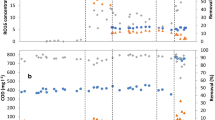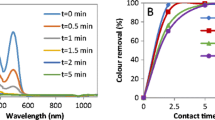Abstract
Colour and COD removals of the azo dyes Congo Red (CR) and Reactive Black 5 (RB5) were individually evaluated in a sequential anaerobic/aerobic treatment system. Additionally, dye toxicity was assessed by using acute ecotoxicity tests with Daphnia magna as the indicator-organism. The anaerobic reactor was operated at approximately 27 °C and with hydraulic retention times of 12 and 24 h. The aerobic reactor was operated in batch mode with a total cycle of 24 h. During anaerobic step, high colour removals were obtained, 96.3% for CR (400 mg/L) and 75% for RB5 (200 mg/L). During the aerobic phase, COD effluent was considerably reduced, with an average removal efficiency of 52% for CR and 85% for RB5, which resulted in an overall COD removal of 88% for both dyes. Ecotoxicity tests with CR revealed that the anaerobic effluent presented a higher toxicity compared with the influent, and an aerobic post-treatment was not efficient in reducing toxicity. However, the results with RB5 showed that both anaerobic and aerobic steps could decrease dye toxicity, especially the aerobic phase, which removed completely the toxicity in D. magna. Therefore, the anaerobic/aerobic treatment is not always effective in detoxifying dye-containing wastewaters, sometimes even increasing dye toxicity.



Similar content being viewed by others
References
WTO. (2010) International trade statistics. ed. World Trade Organization, Geneva
Cervantes, F. J., & dos Santos, A. B. (2011). Reviews in Environmental Science and Biotechnology, 10, 125–137.
dos Santos, A. B., Cervantes, F. J., & van Lier, J. B. (2007). Bioresource Technology, 98, 2369–2385.
Forgacs, E., Cserháti, T., & Oros, G. (2004). Environment International, 30, 953–971.
Pandey, A., Singh, P., & Iyengar, L. (2007). International Biodeterioration and Biodegradation, 59, 73–84.
Alinsafi, A., da Motta, M., Le Bonté, S., Pons, M. N., & Benhammou, A. (2006). Dyes Pigm, 69, 31–39.
Kapdan, I. K., & Kargi, F. (2002). Process Biochemistry, 37, 973–981.
Carliell, C. M., Barclay, S. J., Naidoo, N., Buckley, C. A., Mulholland, D. A., & Senior, E. (1994). Water SA, 20, 341–344.
Costa, M. C., Mota, S., Nascimento, R. F., & Dos Santos, A. B. (2010). Bioresource Technology, 101, 105–110.
van der Zee, F. P., Lettinga, G., & Field, J. A. (2001). Chemosphere, 44, 1169–1176.
van der Zee, F. P., & Villaverde, S. (2005). Water Research, 39, 1425–1440.
Field, J. A., Stams, A. J. M., Kato, M., & Schraa, G. (1995). Antonie Van Leeuwenhoek, 67, 47–77.
Işik, M., & Sponza, D. T. (2004). Journal of Hazardous Materials, 114, 29–39.
Işik, M., & Sponza, D. T. (2006). Enzyme and Microbial Technology, 38, 887–892.
Işik, M., & Sponza, D. T. (2008). Separation and Purification Technology, 60, 64–72.
Libra, J. A., Borchert, M., Vigelahn, L., & Storm, T. (2004). Chemosphere, 56, 167–180.
Lourenço, N. D., Novais, J. M., & Pinheiro, H. M. (2001). Journal of Biotechnology, 89, 163–174.
Lourenço, N. D., Novais, J. M., & Pinheiro, H. M. (2003). Environmental Technology, 24, 679–686.
Ong, S.-A., Toorisaka, E., Hirata, M., & Hano, T. (2005). Separation and Purification Technology, 42, 297–302.
Sponza, D. T., & Işik, M. (2002). Enzyme and Microbial Technology, 31, 102–110.
Sponza, D. T., & Işik, M. (2005). Process Biochemistry, 40, 35–44.
Sponza, D. T., & Işik, M. (2005). Process Biochemistry, 40, 2735–2744.
Bae, J.-S., & Freeman, H. S. (2007). Dyes Pigm, 73, 126–132.
Bae, J.-S., & Freeman, H. S. (2007). Dyes Pigm, 73, 81–85.
Meriç, S., Selçuk, H., & Belgiorno, V. (2005). Water Research, 39, 1147–1153.
Villegas-Navarro, A., González, M. C. R., López, E. R., Aguilar, R. D., & Marçal, W. S. (1999). Environment International, 25, 619–624.
Villegas-Navarro, A., Ramírez-M, Y., Salvador-S, B. M. S., & Gallardo, J. M. (2001). Ecotoxicology and Environmental Safety, 48, 56–61.
Franciscon, E., Zille, A., Fantinatti-Garboggini, F., Silva, I. S., Cavaco-Paulo, A., & Durrant, L. R. (2009). Process Biochemistry, 44, 446–452.
Franciscon, E., Zille, A., Guimaro, F. D., de Menezes, C. R., Durrant, L. R., & Cavaco-Paulo, A. (2009). International Biodeterioration and Biodegradation, 63, 280–288.
Firmino, P. I. M., Silva, M. E. R., Cervantes, F. J., & dos Santos, A. B. (2010). Bioresource Technology, 101, 7773–7779.
ABNT. (2004) NBR 12713-Ecotoxicologia aquática-Toxicidade aguda-Método de ensaio com Daphnia ssp. (Crustacea, Cladocera). ed. Associação Brasileira de Normas Técnicas, Rio de Janeiro
Hao, O. J., Kim, H., & Chiang, P. C. (2000). Critical Reviews in Environmental Science and Technology, 30, 449–505.
APHA. (2005). Standard methods for the examination of water and wastewater (21st ed.). Washington: American Public Health Association.
Buchauer, K. (1998). Water SA, 24, 49–56.
Diniz, P., Lopes, A., Lino, A., & Serralheiro, M. (2002). Applied Biochemistry and Biotechnology, 97, 147–163.
Behling, E., Diaz, A., Colina, G., Herrera, M., Gutierrez, E., Chacin, E., Fernandez, N., & Forster, C. F. (1997). Bioresource Technology, 61, 239–245.
Işik, M., & Sponza, D. T. (2007). Enzyme and Microbial Technology, 40, 934–939.
Weisburger, J. H. (2002). Mutat. Res./Fundam. Mol Mech Mutag, 506–507, 9–20.
Pinheiro, H. M., Touraud, E., & Thomas, O. (2004). Dyes Pigm, 61, 121–139.
Tan, N. C. G. and Field, J. A. (2000) In: Lens, P. and Hulshoff Pol, L. W. (eds.) Environmental technologies to treat sulfur pollution. IWA Publishing, London, pp. 373-392
Bafana, A., Chakrabarti, T., Muthal, P., & Kanade, G. (2009). Ecotoxicology and Environmental Safety, 72, 960–964.
Kapdan, I. K., Tekol, M., & Sengul, F. (2003). Process Biochemistry, 38, 1031–1037.
Kapdan, I. K., & Oztekin, R. (2006). Journal of Hazardous Materials, 136, 896–901.
Tan, N. C. G., van Leeuwen, A., van Voorthuizen, E. M., Slenders, P., Prenafeta-Boldú, F. X., Temmink, H., Lettinga, G., & Field, J. A. (2005). Biodegradation, 16, 527–537.
Acknowledgments
The authors would like to thank Conselho Nacional de Desenvolvimento Científico e Tecnológico–CNPq, an organization of the Brazilian Government for the development of Science and Technology, for the Master’s and PhD scholarships and financial support (Process 470310/2007-3 from Edital Universal).
Author information
Authors and Affiliations
Corresponding author
Rights and permissions
About this article
Cite this article
da Silva, M.E.R., Firmino, P.I.M., de Sousa, M.R. et al. Sequential Anaerobic/Aerobic Treatment of Dye-Containing Wastewaters: Colour and COD Removals, and Ecotoxicity Tests. Appl Biochem Biotechnol 166, 1057–1069 (2012). https://doi.org/10.1007/s12010-011-9493-7
Received:
Accepted:
Published:
Issue Date:
DOI: https://doi.org/10.1007/s12010-011-9493-7




